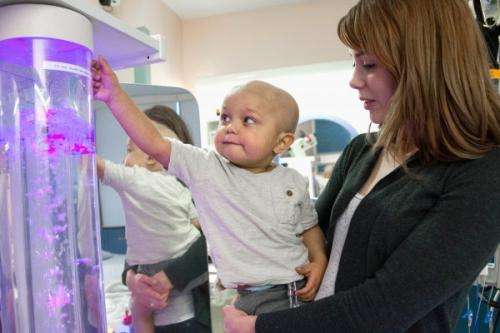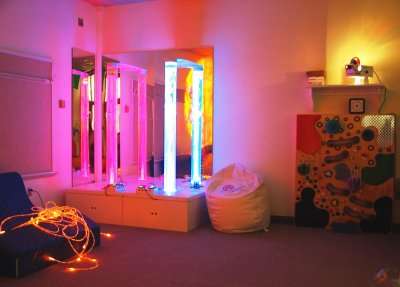Hospital sanctuary aims to soothe or stimulate young patients' senses

It's a sick child's sanctuary, with a big difference. Instead of a hospital bed, there's a mat and chair placed under a shimmering waterfall of fiber optics, a disco ball and stars that dance around the ceiling and change color. Instead of a TV screen, there are toys with fun textures, some that gently vibrate or light up on touch, a giant column of swirling bubbles and a 15-rung ladder of lights with changing colors. And the rubber flooring is interspersed with brightly colored floor squares that make music or silly sounds when you step on them.
Welcome to the multisensory room of the new UCSF Benioff Children's Hospital San Francisco, which will open February 1, 2015, at Mission Bay.
While multisensory rooms have been introduced to select patient populations at a few other hospitals, staff at UCSF's Child Life Services believe they will be beneficial to a broad spectrum of children, based on their ongoing experience in the Parnassus facility of using a "Vecta," a modified version of this equipment that is wheeled around in a single compact unit that has been used for about eight years.
"Children with varying developmental abilities and sensory regulation problems, children in pain or who feel anxious, have been calmed and soothed by watching images that can be projected on the wall of their room or by manipulating toys that change color," said Beatrix Musil, of Child Life Services, who was instrumental in establishing the multisensory room at the new hospital.
"As well as this, the equipment can provide stimulation and offer opportunities to explore using different senses – tactile, visual or hearing," Musil added. "This multisensory exploration can help increase communication for children who may not have the verbal means of communication, and it can increase motivation and build developmental skills.
"Being able to completely change the ambiance of an entire room with the touch of a button can help children feel empowered and in control, which is often lost when they are in the hospital," she said.

A further anticipated use of the room will be for inpatients in the UCSF Amplified Pain Rehabilitation Program, which was set up to help children disabled by severe chronic pain.
"Patients with chronic amplified pain also have chronic stress. Undergoing exercise therapy for pain rehabilitation is physically and emotionally taxing," said William Bernal, MD, a pediatric rheumatologist who heads the program.
"The multisensory room will provide staff with a unique space in which to help patients develop healthy strategies for minimizing pain and stress in the long term. It will be an important non-pharmacologic therapy for chronic pain in children," said Bernal.
Multisensory rooms are also known as "Snoezelen" rooms, a word that comes from the Netherlands, where they originated in the 1970s, and translates as "explore" and "relax." In Europe, Snoezelen rooms were used mainly for children with autism, and developmental or sensory regulation issues. Recent research using multisensory equipment for adults with dementia has led to their use in this patient population in Europe and the U.S.
UCSF Benioff Children's Hospital San Francisco's multisensory room will be open every day by appointment and parents and siblings will be encouraged to participate with the patient. For children who need to remain in their own rooms, the Vecta will continue to be used.
Eventually it is hoped that specialists from Child Life will collaborate with other disciplines, such as occupational and physical therapies, to maximize the use of this dynamic addition to the new hospital.
"We are very excited about the opening of the multisensory room in our new hospital," said Michael Towne, manager of Child Life Services. "We believe this is a valuable tool that will aid recovery and boost quality of life for all our young patients."

















